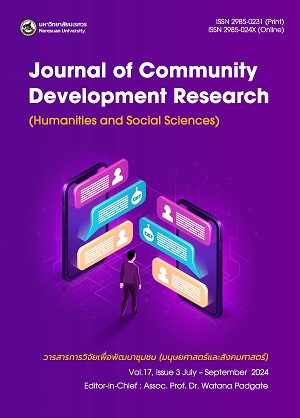The Perceptions of Thai and International Lecturers of English in Using an Online Platform
##plugins.themes.bootstrap3.article.main##
Abstract
Even with the resumption of physical classes following the pandemic outbreak, various educational institutions tend to remain using online platforms, although not entirely employed. Considering this matter, it is plausible to scrutinize perceptions of instructors as inevitable users, as well as the effectiveness, advantages, and disadvantages of online instructional platforms. The objective of this study is to investigate the viewpoints of lecturers who remain utilizing virtual platforms. It examines the perceptions of Thai and international university English lecturers regarding the utilization of online platforms and explores any difficulties they might have encountered in their EFL classes. Adopting a qualitative approach, the data were collected through semi-structured interviews. The findings indicate that Thai and international English instructors at a Thai university view online platforms positively due to their user-friendliness and practicality. Key factors influencing these perceptions include perceived usefulness, ease of use, and self-efficacy. The benefits highlighted in the research encompass class accessibility, time and cost savings, and enhanced class organization. However, despite recognizing these advantages, there is a preference for traditional onsite classes over online alternatives. This may result from challenges experienced in online classes, notably related to students, such as Internet connectivity issues, a less motivating atmosphere, concerns over academic integrity, and diminished teacher-student interaction. Consequently, while online platforms can serve as supplementary resources for English classes, they may not fully replace traditional onsite classes but could be utilized as substitutes when required.
Keywords: Online Platform, Online Learning and Teaching, English Teaching, Teachers’ Perception, Problems in Online Classes, Tat
References
Al-Sharah, N., Awwad, S., Abd Hamid, J., Shukri, S. M., & Ariffin, I. A. (2021). EFL Teachers’ Perceptions Towards English Language Teaching During the Pandemic: Jordanian Perceptive. Eurasian Journal of Applied Linguistics, 7(2), 171-185. Retrieved from https://ejal.info/article-view/?id=115
Civelek, M., Toplu, I., & Uzun, L. (2021). Turkish EFL Teachers’ Attitudes Towards Online Instruction Throughout the COVID-19 Outbreak. English Language Teaching Educational Journal, 4(2), 87-98. https://doi.org/10.12928/eltej.v4i2.3964
Davis, F. D. (1989). Perceived Usefulness, Perceived Ease of Use, and User Acceptance of Information Technology. MIS Quarterly, 13(3), 319–340. https://doi.org/10.2307/249008
Fakhrunisa, F., & Prabawanto, S. (2020). Online Learning in COVID-19 Pandemic: An Investigation of Mathematics Teachers’ Perception. In ICEEL 2020: 2020 The 4th International Conference on Education and E-Learning, November 6-8, 2020 (pp. 207-213). https://doi.org/10.1145/3439147.3439179
Giovannella, C., Passarelli, M., & Persico, D. (2020). Measuring the Effect of the COVID-19 Pandemic on the Italian Learning Ecosystems at the Steady State: A School Teachers’ Perspective. Interaction Design & Architecture(s) Journal (IxD&A), 45, 264–286.
Huy, N. D. (2021). Perceptions of EFL Tertiary Students Towards the Correlation between e-Learning and Learning Engagement During the COVID-19 Pandemic. International Journal of TESOL & Education, 1(3), 235-259. Retrieved from https://i-jte.org/index.php/journal/article/view/99
Khlaisang, J., Huang, F., Koraneekij, P., & Teo, T. (2023). Using Mobile Technologies to Teach 21st Century Learning Skills: A Study of Teachers’ Acceptance in Thai Secondary Schools. International Journal of Mobile Learning and Organisation, 17(1-2), 254-279. https://doi.org/10.1504/ijmlo.2023.128343
Kizlik, B. (2007). Getting Ready for Distance Education Distance Education Aptitude and Readiness Scale (DEARS). Retrieved from http://www.adprima.com/dears.htm
Klapproth, F., Federkeil, L., Heinschke, F., & Jungmann, T. (2020). Teachers’ Experiences of Stress and their Coping Strategies During COVID-19 Induced Distance Teaching. Journal of Pedagogical Research, 4(4), 444-452. https://doi.org/10.33902/JPR.2020062805
Nambiar, D. (2020). The Impact of Online Learning During COVID-19: Students’ and Teachers’ Perspective. The International Journal of Indian Psychology, 8(2), 783-793. Retrieved from https://ijip.in/
articles/the-impact-of-online-learning-during-covid-19-students-and-teachers-perspective/
Pal, D., & Vanijja, V. (2020). Perceived Usability Evaluation of Microsoft Teams as an Online Learning Platform During COVID-19 Using System Usability Scale and Technology Acceptance Model in India. Children and Youth Services Review, 119, 105535. https://doi.org/10.1016/j.childyouth.2020.105535
Panigrahi, R., Srivastava, P. R., & Sharma, D. (2018). Online Learning: Adoption, Continuance, and Learning Outcome—A Review of Literature. International Journal of Information Management, 43, 1–14. https://doi.org/10.1016/j.ijinfomgt.2018.05.005
Pusvitasari, R., Viriyavejakul, C., & Sumettikoon, P. (2023). An Investigation of Graduate Students’ Usage of Synchronous Learning Platforms in the Post COVID-19 Era. Journal of Southwest Jiaotong University, 58(2), 331-343. Retrieved from http://jsju.org/index.php/journal/article/view/1593
Rahayu, R. P., & Wirza, Y. (2020). Teachers’ Perception of Online Learning During Pandemic COVID-19. Jurnal Penelitian Pendidikan, 20(3), 392-406.
Shatri, K., Buza, K., & Bunjaku, F. (2021). Teachers’ Perception on the Benefits of Using Online Resources. International Journal of Emerging Technologies in Learning (iJET), 16(11), 289-307. https://doi.org/10.3991/ijet.v16i11.21407
Songkram, N., & Osuwan, H. (2022). Applying the Technology Acceptance Model to Elucidate K-12 Teachers’ Use of Digital Learning Platforms in Thailand During the COVID-19 Pandemic. Sustainability, 14(10), 6027. https://doi.org/10.3390/su14106027
Tappoon, A. (2021). Voices of EFL Teachers in Online Teaching Amid COVID-19 Pandemic Period in Bangkok. In 2021 6th International Conference on Business and Industrial Research (ICBIR), Bangkok, Thailand, May 20-21, 2021 (pp. 192-196). https://doi.org/10.1109/ICBIR52339.2021.9465870
Teo, T., & Huang, F. (2019). Investigating the Influence of Individually Espoused Cultural Values on Teachers’ Intentions to Use Educational Technologies in Chinese Universities. Interactive Learning Environments, 27(5-6), 813-829. https://doi.org/10.1080/10494820.2018.1489856
ugli Juraboyev, B. B. (2021). Problems and Solutions for Online Teaching and Learning of Foreign Languages. Academic Research in Educational Sciences, 2(Special 2), 127-131.
Venkatesh, V. (2000). Determinants of Perceived Ease of Use: Integrating Control, Intrinsic Motivation, and Emotion into the Technology Acceptance Model. Information Systems Research, 11(4), 342–365. https://doi.org/10.1287/isre.11.4.342.11872
Wang, L.-Y.-K., Lew, S.-L., Lau, S.-H., & Leow, M.-C. (2019). Usability Factors Predicting Continuance of Intention to Use Cloud e-learning Application. Heliyon, 5(6), e01788. https://doi.org/10.1016/j.heliyon.2019.e01788
